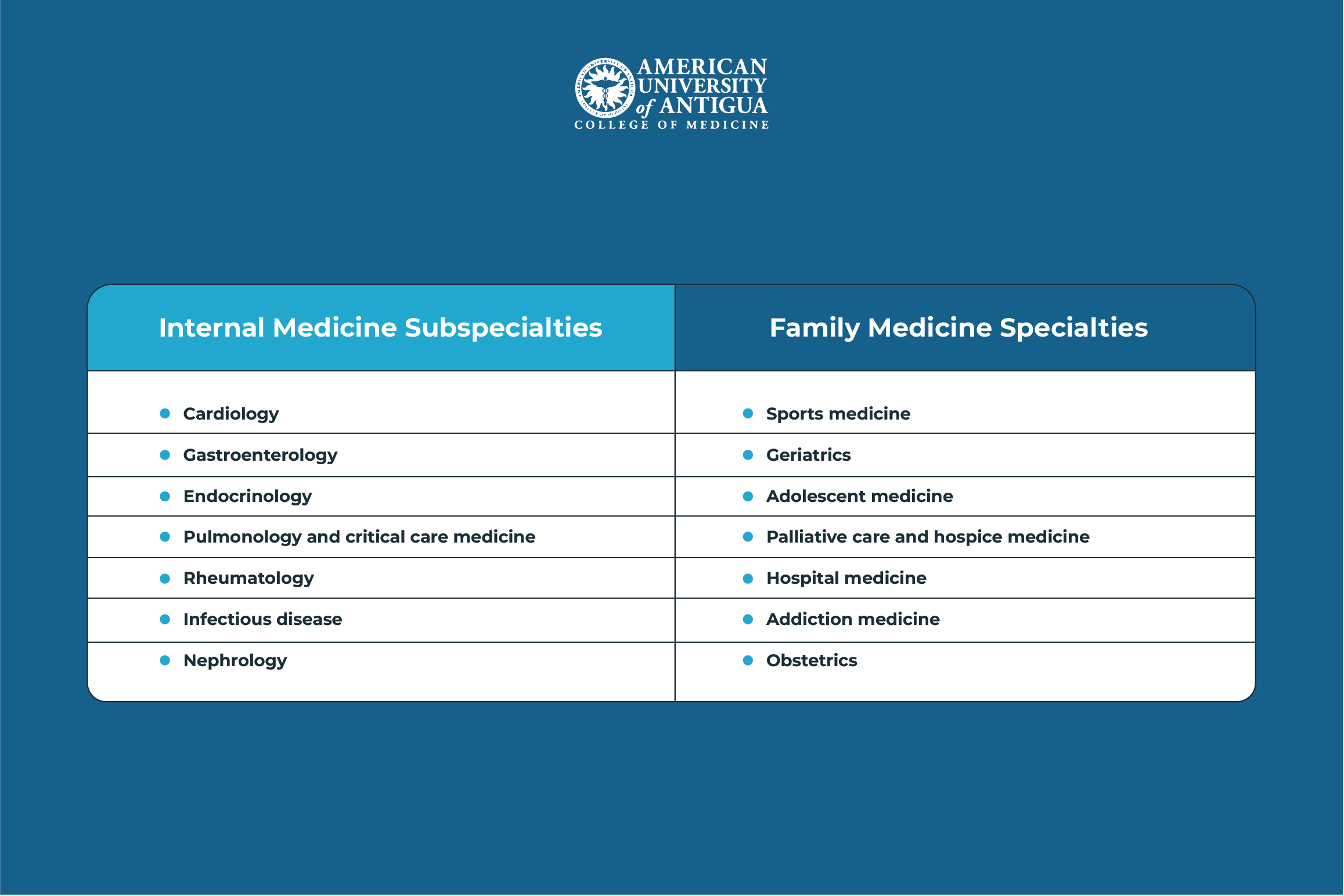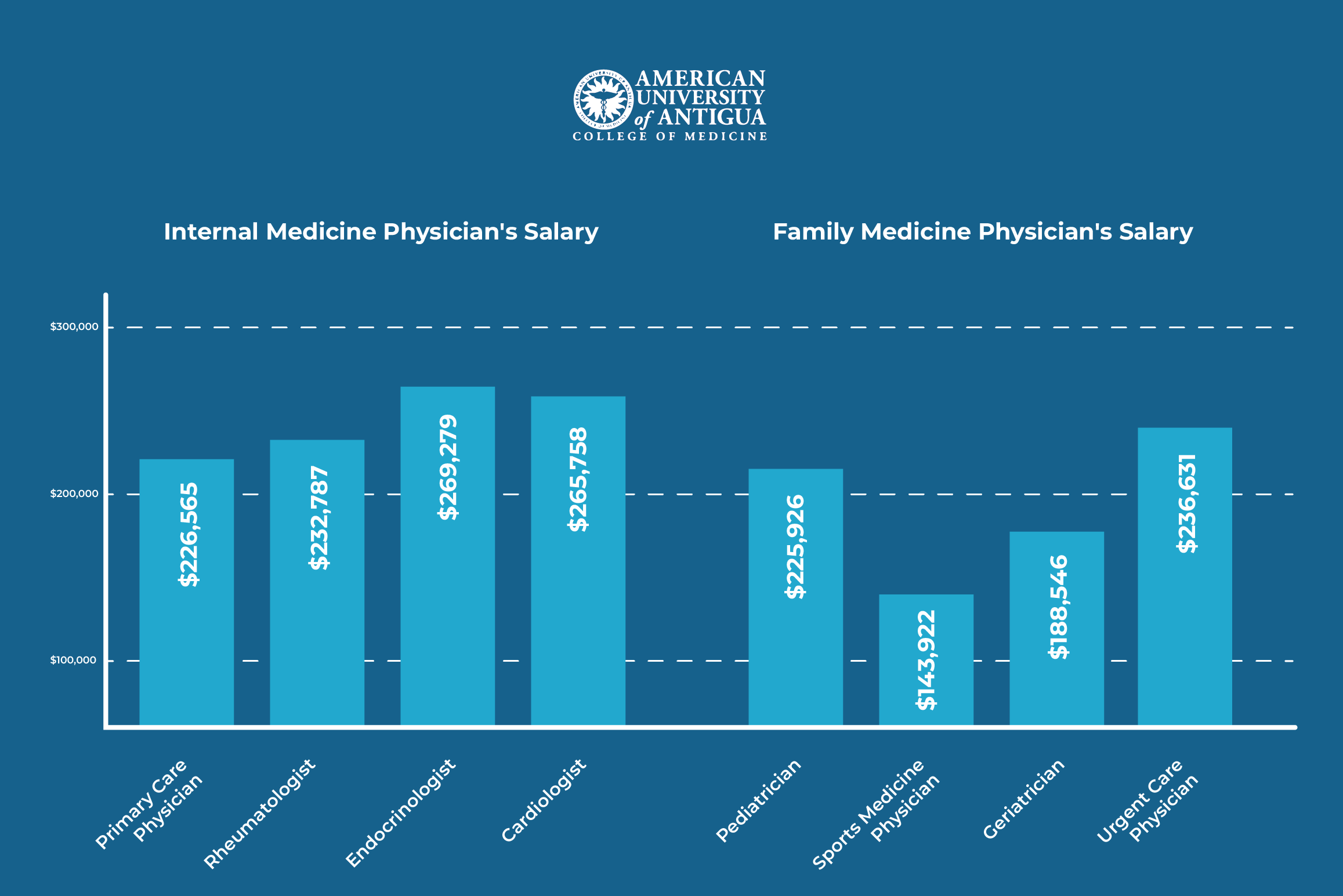Internal Medicine vs. Family Medicine: Unraveling the Differences
The field of medicine provides an unmatched range of opportunities for aspiring doctors. It offers a diverse landscape of specialties, ensuring that every individual interested in medicine can find their niche where they can flourish and make a significant impact.
At times, choosing a medical specialty can be overwhelming due to the wide range of options available. A difficult decision often faced by medical professionals revolves around choosing between two prominent branches: internal medicine vs. family medicine. Both fields possess distinctive merits, addressing varied scopes of patient care, and represent rewarding pathways in their own right. However, in the end, only one can be the “better” choice for you.
✅ Request information on AUA's MD program TODAY!
YOUR PATH TO SUCCESS BEGINS HERE
What Is the Difference Between Internal Medicine and Family Medicine?
The difference between internal medicine and family medicine lies in their scopes of practice and patient populations. While both specialties share many similarities, it’s crucial to distinguish their unique characteristics to make an informed decision about which one is better suited for individual career aspirations.
Below, we’ll put family medicine vs. internal medicine head to head in various categories, from the education and training required to the salaries associated with each field.
Defining internal medicine
Internal medicine is a specialized branch of healthcare dedicated to the comprehensive care of adults. Practitioners in this field, commonly referred to as internists, focus on preventing, diagnosing, and treating various illnesses that commonly affect grown-ups, encompassing everything from long-standing health concerns to more immediate, short-term issues. They play a crucial role in promoting and maintaining the health and well-being of individuals as they navigate through different stages of adulthood.
Defining family medicine
Family medicine is another specialized field of healthcare. However, this one prioritizes the comprehensive care of individuals across all age groups, from infants to older people. Physicians practicing family medicine, known as family practitioners, are trained to provide a broad spectrum of healthcare services, including preventive care, routine check-ups, and managing acute and chronic conditions. They serve as the cornerstone of healthcare for many families, establishing enduring doctor-patient relationships that contribute significantly to the well-being and health promotion of the entire family unit.
Education and Training: Internal Medicine
First, you must earn a bachelor’s degree from an accredited college or university, which typically spans four years of full-time study. Many choose biology, biochemistry, or physics majors, aligning with a pre-medical track. It’s also beneficial to take courses in subjects like math and English, which are often prerequisites for medical school.
The next stage is applying to a medical school program and earning a medical degree. Students usually engage in extensive classroom learning in the initial year, covering anatomy, pathology, histology, and ethics. Subsequently, the second year emphasizes applying this knowledge in clinical settings. The final two years often involve clinical rotations and preparation for residency. After completing medical school, the next phase is to seek a residency program in internal medicine, which typically spans three years.
Finally, following the completion of residency, obtaining licensure and certification as a physician is crucial. This involves passing state exams to earn medical licenses and optionally pursuing board certification. Once certified, aspiring internists can begin applying for positions in their field. Networking, online resources, and job search websites can all be valuable tools in finding suitable job openings.
Education and Training: Family Medicine
To become a family medicine doctor, you’ll follow a series of steps similar to those for internists, starting from a bachelor’s degree in majors such as biology and chemistry and then moving on to around seven years of medical training, including four years spent in medical school and three years spent in a family medicine residency.
During the three years spent in family medicine residency, students explore various medical disciplines, honing their expertise in providing comprehensive healthcare to individuals of all ages. Moreover, family medicine residents gain valuable experience in understanding the unique dynamics of family relationships and their impact on health.
Clinical Focus and Patient Care: Internal Medicine
Internal medicine is primarily concerned with diagnosing, treating, and preventing diseases that affect adults, including various chronic illnesses, that often require a deeper understanding of the intricate workings of the anatomy of adult humans.
Internal medicine professionals are responsible for conducting comprehensive assessments and utilizing specialized tests to reach accurate diagnoses. Their clinical expertise covers internal organs and systems like the heart, lungs, liver, and kidneys. Internists are also skilled in managing care for patients with multiple health issues, guaranteeing that treatment plans are coordinated and successful.
Their approach to patient care involves long-term relationships built on trust and expertise, making them invaluable partners in maintaining the health and well-being of adult patients.
Clinical Focus and Patient Care: Family Medicine
On the other hand, family medicine takes a more holistic approach to healthcare, focusing on providing comprehensive and continuous care for individuals and families across all stages of life.
Family medicine practitioners are dedicated to addressing various medical needs and emphasize the importance of preventive measures, promoting healthy lifestyles, and early detection of potential health issues. They build enduring relationships with their patients, allowing for a deeper understanding of individual and family dynamics that may influence health.
This approach fosters trust and open communication, creating a supportive environment for addressing physical health and emotional and social well-being.
Key Skills: Internal Medicine
Internists possess specialized skills and traits that enable them to provide exceptional care to adult patients. Some of these skills and abilities include:
- Proficiency in accurately diagnosing a wide range of complex medical conditions
- Ability to conduct thorough and comprehensive assessments of patients, considering both physical and medical history
- Understanding the anatomy and physiology of adult humans, including internal organs and systems
- Expertise in managing chronic illnesses that commonly affect adults
- Ability to formulate and implement effective treatment plans, including medication management and therapeutic interventions
- Knowledge and experience in ordering and interpreting specialized tests and medical imaging
- Organizational skills, ensuring the coordination of care for patients with multiple health issues
- Willingness to stay updated with the latest medical research and applying evidence-based practices in clinical decision-making
- Excellent communication skills with patients, colleagues, and other healthcare professionals
Key Skills: Family Medicine
Likewise, working in family medicine entails the development of the following skills and traits:
- Competence in treating children and adolescents, including well-child visits, vaccinations, and developmental assessments
- Expertise in addressing the healthcare needs of older adults, including age-related conditions and geriatric syndromes
- Knowledge of women’s health issues, including gynecological care, family planning, and prenatal care
- Counseling skills to provide patients and families with health education, lifestyle recommendations, and emotional support
- Skills in managing chronic conditions in patients of all ages, adapting care plans to individual needs
- Sensitivity and proficiency in providing care that respects diverse cultural backgrounds and values
- Coordination skills when dealing with specialists and other healthcare providers to ensure comprehensive and well-integrated care for patients
Subspecialties and Fellowships

Both internal medicine and family medicine are separate medical specialties with their unique approaches to healthcare. However, both fields also offer various subspecialties that allow professionals to dive deeper into specific areas of interest.
During their residency, aspiring physicians can narrow their focus and hone their expertise in specialized domains or pursue fellowships, enabling them to become true specialists in their chosen subspecialty. This further enhances their ability to provide specialized and advanced care to their patients.
Some subspecialties for internal medicine include but are not limited to:
- Cardiology
- Gastroenterology
- Endocrinology
- Pulmonology and critical care medicine
- Rheumatology
- Infectious disease
- Nephrology
Family medicine also encompasses a broad scope of primary care, but there are also opportunities for physicians to pursue additional training and expertise in specific areas such as:
- Sports medicine
- Geriatrics
- Adolescent medicine
- Palliative care and hospice medicine
- Hospital medicine
- Addiction medicine
- Obstetrics
Career Opportunities and Salaries

According to the Bureau of Labor Statistics (BLS), the overall employment outlook for physicians and surgeons, including internal medicine and family medicine practitioners, is projected to experience a modest 3% growth from 2022 to 2032. This growth rate is in line with the average for all occupations. Nevertheless, it’s important to note that notable disparities exist in terms of salaries between these specialties.
The average annual total pay for an internal medicine physician in the United States is approximately $231,847, with salaries varying between $174,000 and $316,000. Some high-paying career paths available within the field of internal medicine include:
- Primary care physician, with an average total pay of $226,565 per year
- Rheumatologist, with an average total pay of $232,787 per year
- Endocrinologist, with an average total pay of $269,279 per year
- Cardiologist, with an average total pay of $265,758 per year
On the other hand, the average annual pay for professionals in family medicine is around $222,459, with salaries ranging from $169,000 to $294,000 per year. Additionally, some lucrative career paths in this field include:
- Pediatrician, with an average total pay of $225,926 per year
- Sports medicine physician, with an average total pay of $143,922 per year
- Geriatrician, with an average total pay of $188,546 per year
- Urgent care physician, with an average total pay of $236,631 per year
Internal Medicine vs. Family Medicine: Which One Is Right for You?
Choosing between a career in internal medicine and family medicine is an important decision for aspiring medical professionals since both specialties offer distinct approaches to patient care, and finding the right fit depends on individual interests, career goals, and personal inclinations.
If you have a passion for treating patients of all ages, value the continuity of care within families, and believe in the importance of preventive care, then family medicine might be the best fit for you. On the other hand, if you have a specific interest in the complexities of adult healthcare and find satisfaction in unraveling complex medical cases, conducting in-depth evaluations, and formulating precise treatment plans for various conditions in adults, then internal medicine could be the better choice.
The Bottom Line
In the battle of internal vs. family medicine, there is not one objective winner; rather, both stand as excellent specialty options, offering various opportunities for medical professionals to thrive. The choice between the two ultimately hinges on how you envision your future as a doctor.
As you ponder this decision, remember that your journey in medicine should start with a strong foundation. So, consider joining our medical school, where you’ll receive the education and support necessary to excel in whichever specialty you choose.
FAQ
Why is it called internal medicine?
The term “internal” originated in the 19th century and refers to the body’s internal organs and systems, reflecting the specialty’s dedication to understanding and managing illnesses that emerge within the body.
Are internists and family physicians primary care physicians?
Yes, both internists and family physicians are considered primary care physicians. They provide initial healthcare, manage common illnesses, and coordinate specialized care when needed.
✅ Request information on AUA's MD program TODAY!
YOUR PATH TO SUCCESS BEGINS HERE
✅ Request information on AUA's MD program TODAY!

